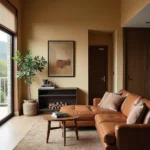Pewter, a captivating metallic hue with a rich history, often sparks debate among design enthusiasts: is pewter a warm or cool color? The answer, as with many aspects of color perception, is nuanced and depends on various factors.
Understanding Color Temperature
Before diving into pewter’s complexities, let’s establish the fundamentals of color temperature. In the world of design, colors are broadly categorized as warm or cool based on their psychological associations:
- Warm colors: Evoking feelings of warmth, energy, and optimism, these hues include reds, oranges, yellows, and their variations.
- Cool colors: Suggesting tranquility, calmness, and serenity, these hues encompass blues, greens, purples, and their variations.
Decoding Pewter’s Undertones
Pewter’s position on the color spectrum is fascinatingly ambiguous. It is essentially a shade of gray, but its inherent complexity stems from its subtle undertones, which can lean towards blue, green, or even brown. These undertones are the key to determining whether a particular pewter appears warm or cool.
- Blue or green undertones: Infuse pewter with a cooler, almost icy feel, often perceived as sophisticated and elegant. Imagine a what color hardware with white cabinets in a modern kitchen, adding a sleek touch.
- Brown or beige undertones: Lend pewter a warmer, more earthy and inviting quality, often associated with rustic or traditional aesthetics.
Factors Influencing Pewter’s Temperature
Beyond undertones, other factors can influence how we perceive the warmth or coolness of pewter:
- Lighting: Natural and artificial light play a significant role in how colors appear. Warm lighting can enhance pewter’s inherent warmth, while cool lighting can accentuate its cooler undertones.
- Surrounding Colors: The colors surrounding pewter can create contrast and impact its perceived temperature. For example, pairing pewter with cool blues and greens will amplify its coolness, while pairing it with warm browns and reds can bring out its warmer side.
Pewter in Interior Design
Pewter’s versatility makes it a popular choice for various interior design styles. Its ability to shift between warm and cool allows it to adapt to different moods and aesthetics.
Cool Pewter: Ideal for creating spaces that are calm, sophisticated, and modern:
- Bedrooms: A cool pewter can create a tranquil ambiance, promoting relaxation and restful sleep.
- Bathrooms: Pewter’s association with metal makes it a fitting choice for bathrooms, where it can be used for fixtures, tiles, and accent walls.
- Modern Kitchens: Cool pewter pairs beautifully with stainless steel appliances and minimalist décor, adding a touch of understated elegance.
Warm Pewter: Perfect for adding depth and character to cozy, traditional, or rustic spaces:
- Living Rooms: Warm pewter can create a welcoming and comfortable atmosphere, making it ideal for gathering with family and friends.
- Dining Rooms: Pewter’s subtle warmth can enhance the richness of wood furniture and create an inviting setting for meals.
- Home Offices: A warm pewter can create a focused yet inviting workspace.
Tips for Using Pewter
- Sample, Sample, Sample: Always test pewter paint colors in your space and at different times of the day to see how they interact with your lighting and existing décor.
- Consider the Room’s Function: Think about the mood you want to create in the space. Cool pewter is better suited for spaces where you want to evoke a sense of calm and serenity, while warm pewter is ideal for spaces where you want to create a welcoming and inviting atmosphere.
- Balance is Key: Pewter, whether warm or cool, can be a dominant color. Balance it with other colors and textures to create a cohesive and visually appealing space.
Pewter, with its enigmatic blend of gray and subtle undertones, transcends the limitations of a simple warm or cool label. Its ability to adapt to different lighting conditions, surrounding colors, and design styles makes it a truly versatile and captivating hue.
FAQs
-
Can pewter be used as a neutral color?
Absolutely! Pewter’s inherent grayness makes it an excellent neutral. Its subtle warmth or coolness can add depth and interest without overpowering other colors.
-
What are some colors that pair well with pewter?
Pewter is incredibly versatile. It pairs beautifully with a wide range of colors, including:
- Warm Palette: Cream, beige, brown, red, yellow
- Cool Palette: White, blue, green, lavender
- Metallic Accents: Gold, silver, copper
-
Can I use pewter on both walls and trim?
Yes, but be mindful of contrast. Consider using a slightly lighter shade of pewter for the trim to create subtle definition.
-
Does pewter work well in small spaces?
Lighter shades of pewter can actually make small spaces appear larger, especially when paired with plenty of natural light.
-
Is pewter a good choice for exterior paint?
Pewter is becoming increasingly popular as an exterior paint color. It offers a timeless and elegant look that complements a variety of architectural styles.
Need More Color Inspiration?
Explore the world of color possibilities with these additional resources:
- What color eye makeup for red dress: Find the perfect eye makeup shades to complement your stunning red dress.
- What color looks best on brown skin: Discover the colors that will flatter your beautiful brown skin tone.
Contact Us:
For personalized color consultations and expert advice on creating your dream space, contact Color Box Hanoi today.
Phone: 0373298888
Email: [email protected]
Address: 86 Cầu Giấy, Hà Nội.
Our team of color specialists is available 24/7 to assist you.

